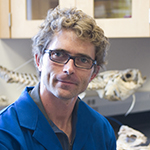 Pierre Le Pabic, postdoctoral fellow in Developmental and Cell Biology in the laboratory of Professor Thomas Schilling, recently identified three proteins, Fat3, Dachsous2 and REREa, which could be targets for resolving birth defects. Le Pabic’s study was published in the October 23 issue of PLoS Genetics.
Pierre Le Pabic, postdoctoral fellow in Developmental and Cell Biology in the laboratory of Professor Thomas Schilling, recently identified three proteins, Fat3, Dachsous2 and REREa, which could be targets for resolving birth defects. Le Pabic’s study was published in the October 23 issue of PLoS Genetics.
In this study, Le Pabic and colleagues found that Fat3, Dachous2 and REREa are required for skeletal morphogenesis in developing embryos. By understanding the molecular and genetic regulators of cellular behavior during cartilage development, scientists are one step closer to identifying potential causes and therapies for human birth defects, including cleft palate and micrognathia.
Le Pabic and his colleagues studied cellular behavior in zebrafish and found that cells of the skeleton do not assemble properly in those embryos with a reduced amount of Fat3-, Dachsous2-, or REREa protein, which resulted in misshapen cartilage structures. Fat3, Dachsous2 and REREa allow cartilage cells to coordinate their behavior and differentiation through cell-to-cell communication.
The scientists hope that further exploration of how morphogenesis and differentiation are coordinated will lead to an understanding of the development of many other organs and tissues, and potentially provide insights into novel organ regeneration strategies.
If you’d like to learn more about how you can support the faculty and research at the Biological Sciences School, please contact Andrew DiNuzzo at 949.824.2734 or adinuzzo@uci.edu.
